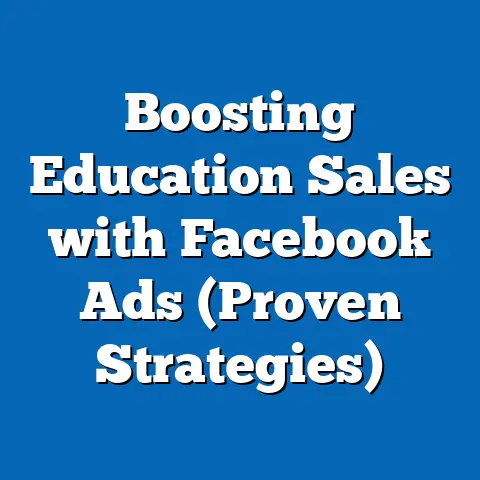Craft Winning Facebook Ads for Clients (Proven Strategies)
Imagine crafting Facebook ads like preparing a gourmet meal. Just as a chef meticulously selects ingredients, balances flavors, and adjusts seasoning to create a dish that delights the palate, as marketers, we must carefully choose our elements – target audiences, ad copy, visuals, and calls to action – to create Facebook ads that resonate with viewers and drive conversions. This article is your recipe book for creating those winning ads for your clients.
Understanding the Client’s Goals
Before diving into the specifics of ad creation, the most crucial step is understanding your client’s goals. You can’t create effective ads in a vacuum. You need to know what your client wants to achieve. Are they looking to increase brand awareness, generate leads, drive sales, or boost website traffic? The answer to this question will directly influence every aspect of your campaign, from targeting to ad copy.
Identifying Target Audience Personas
Once you understand the client’s overarching goals, you need to define the target audience. Don’t rely on assumptions. Conduct thorough research to create detailed buyer personas. What are their demographics, interests, behaviors, and pain points? What motivates them? Where do they spend their time online?
I remember working with a client who sold eco-friendly baby products. Initially, they wanted to target all new parents. However, after conducting market research, we discovered that their ideal customer was a millennial mom who was passionate about sustainability and actively sought out organic and ethically sourced products. By narrowing our focus, we significantly improved our ad performance and conversion rates.
Aligning Ad Strategies with Client Expectations
It’s essential to align your ad strategies with the client’s expectations and define key performance indicators (KPIs) upfront. What metrics will you use to measure success? Is it click-through rate (CTR), conversion rate, cost per acquisition (CPA), or return on ad spend (ROAS)? Having a clear understanding of these KPIs will help you track your progress, optimize your campaigns, and demonstrate the value you’re providing to your client.
Takeaway: Don’t start creating ads until you have a solid understanding of your client’s goals, target audience, and key performance indicators. This groundwork is essential for creating successful campaigns.
Crafting Compelling Ad Copy
Compelling ad copy is the heart of any successful Facebook ad. It’s what captures the attention of your target audience and persuades them to take action. The key elements of persuasive ad copy include a strong headline, engaging body text, and a clear call to action.
Writing Attention-Grabbing Headlines
Your headline is the first thing people see, so it needs to be attention-grabbing. Use strong verbs, numbers, and questions to pique interest. For example, instead of “Learn More About Our Product,” try “Discover the Secret to [Desired Outcome]” or “5 Ways to [Solve a Common Problem].”
I’ve found that using power words like “secret,” “discover,” “ultimate,” and “proven” can significantly boost click-through rates. Also, try to create a sense of urgency or scarcity. For example, “Limited-Time Offer” or “Don’t Miss Out.”
Clarity and Brevity in Messaging
In today’s fast-paced digital world, people have short attention spans. Your ad copy needs to be clear, concise, and easy to understand. Avoid jargon and technical terms that your target audience may not be familiar with. Get straight to the point and highlight the key benefits of your client’s product or service.
Examples of Effective Ad Copy
Here are some examples of effective ad copy for various industries:
- E-commerce (Clothing): “New Arrivals Just Dropped! Shop our latest collection of stylish and affordable clothing. Free shipping on orders over $50. Shop Now!”
- Software (CRM): “Stop wasting time on manual tasks. Our CRM software automates your sales process and helps you close more deals. Try it free for 14 days!”
- Local Business (Restaurant): “Craving something delicious? Our new summer menu is here! Try our signature dish, [Dish Name], and get a free appetizer. Book your table now!”
Takeaway: Crafting compelling ad copy requires a deep understanding of your target audience and their needs. Use strong headlines, clear messaging, and a compelling call to action to drive engagement and conversions.
Designing Eye-Catching Visuals
Visuals are just as important as ad copy when it comes to capturing attention on Facebook. In fact, studies show that visuals are processed 60,000 times faster than text. High-quality images or videos can make your ads stand out from the crowd and help you convey your message more effectively.
Selecting Resonant Visuals
Choose visuals that resonate with your target audience and reflect your client’s brand. Consider the demographics, interests, and preferences of your target audience when selecting images or videos. Use visuals that are relevant to your ad copy and highlight the key benefits of your client’s product or service.
I once worked with a travel agency that was promoting a vacation package to the Maldives. Instead of using generic stock photos, we used user-generated content (UGC) from previous customers who had visited the Maldives. The authentic photos and videos resonated with our target audience and resulted in a significant increase in bookings.
Color Psychology
Color psychology plays a crucial role in ad performance. Different colors evoke different emotions and associations. For example, blue is often associated with trust and reliability, while red is associated with excitement and energy. Use colors that are consistent with your client’s brand and that will resonate with your target audience.
Examples of Successful Ad Visuals
Here are some examples of successful ad visuals and why they work:
- E-commerce (Beauty): A close-up photo of a model with flawless skin using the client’s skincare product. The visual is aspirational and demonstrates the effectiveness of the product.
- Software (Project Management): A short video demonstrating how the client’s software can help teams collaborate and manage projects more efficiently. The video is informative and engaging.
- Local Business (Gym): A before-and-after photo of a client who has achieved their fitness goals using the gym’s services. The visual is inspiring and demonstrates the value of the gym’s programs.
Takeaway: Invest in high-quality visuals that are relevant to your target audience and reflect your client’s brand. Consider color psychology and use visuals that evoke the desired emotions and associations.
Utilizing Targeting Options Effectively
Facebook’s targeting options are incredibly powerful, allowing you to reach specific audiences based on demographics, interests, behaviors, and more. Mastering these options is crucial for maximizing the effectiveness of your ad campaigns.
Demographic, Interest, and Behavioral Targeting
Facebook allows you to target users based on a wide range of demographic factors, such as age, gender, location, education, and income. You can also target users based on their interests, such as hobbies, sports, music, and movies. Additionally, you can target users based on their behaviors, such as purchase history, online activity, and device usage.
Custom and Lookalike Audiences
Custom audiences allow you to target users who have already interacted with your client’s business, such as website visitors, email subscribers, and customers. Lookalike audiences allow you to reach new users who are similar to your existing customers. These options can significantly improve your ad performance by targeting users who are more likely to be interested in your client’s products or services.
A/B Testing Audience Segments
Don’t assume that you know which audience segments will perform best. Use A/B testing to experiment with different audience segments and see which ones generate the best results. Create multiple ad sets with different targeting options and track their performance. This will help you identify the most effective audience segments for your client’s ads.
Takeaway: Facebook’s targeting options are incredibly powerful, but they need to be used strategically. Take the time to understand the different targeting options available and experiment with different audience segments to optimize your ad reach.
Setting Up and Managing Ad Campaigns
Setting up a Facebook ad campaign is a straightforward process, but it’s important to pay attention to the details to ensure that your ads are running effectively.
Selecting Objectives, Budget, and Ad Placements
The first step is to select your campaign objective. What do you want to achieve with your ads? Are you looking to increase brand awareness, generate leads, drive sales, or boost website traffic? Facebook offers a variety of campaign objectives to choose from, so select the one that aligns with your client’s goals.
Next, you need to set your budget. How much are you willing to spend on your ads? You can set a daily budget or a lifetime budget. It’s important to start with a reasonable budget and gradually increase it as you see results.
Finally, you need to choose your ad placements. Where do you want your ads to appear? Facebook offers a variety of ad placements, including the Facebook News Feed, Instagram Feed, Audience Network, and Messenger. Experiment with different ad placements to see which ones perform best for your client.
Monitoring Ad Performance
Once your campaign is up and running, it’s important to monitor its performance using Facebook Analytics. Track key metrics such as click-through rate (CTR), conversion rate, cost per acquisition (CPA), and return on ad spend (ROAS). This will help you identify areas where you can improve your campaign.
Adjusting Campaigns Based on Performance Data
Based on the data you collect, you may need to adjust your campaign. This could involve changing your targeting options, ad copy, visuals, or budget. Don’t be afraid to experiment and make changes to your campaign to improve its performance.
Takeaway: Setting up a Facebook ad campaign is a straightforward process, but it’s important to pay attention to the details to ensure that your ads are running effectively. Monitor your ad performance and make adjustments as needed to optimize your results.
Analyzing Results and Learning from Data
Analyzing the results of your Facebook ad campaigns is crucial for understanding what’s working and what’s not. By tracking key metrics and interpreting the data, you can continuously improve your campaigns and achieve better results for your clients.
Key Metrics to Track
Here are some of the key metrics to track for Facebook ad success:
- Click-Through Rate (CTR): The percentage of people who saw your ad and clicked on it. A high CTR indicates that your ad copy and visuals are resonating with your target audience.
- Conversion Rate: The percentage of people who clicked on your ad and completed a desired action, such as making a purchase, filling out a form, or subscribing to a newsletter. A high conversion rate indicates that your landing page is effective and that your offer is compelling.
- Cost Per Acquisition (CPA): The average cost of acquiring a new customer through your Facebook ads. A low CPA indicates that your campaign is efficient and that you’re getting a good return on your investment.
- Return on Ad Spend (ROAS): The amount of revenue generated for every dollar spent on Facebook ads. A high ROAS indicates that your campaign is profitable and that you’re generating a good return on your investment.
Interpreting Data
Don’t just track the metrics – interpret them. What do they tell you about your target audience, your ad copy, your visuals, and your landing page? Are you reaching the right people? Are your ads engaging and persuasive? Is your landing page optimized for conversions?
Ongoing Learning and Adaptation
The landscape of Facebook advertising is constantly evolving. New features, targeting options, and best practices are constantly being introduced. It’s important to stay up-to-date on the latest trends and adapt your strategies accordingly. Attend industry conferences, read blog posts, and follow social media influencers to stay informed.
Takeaway: Analyzing the results of your Facebook ad campaigns is crucial for understanding what’s working and what’s not. Track key metrics, interpret the data, and continuously learn and adapt to improve your results.
Conclusion
Crafting winning Facebook ads for clients requires a combination of creativity, strategy, and data analysis. By understanding your client’s goals, crafting compelling ad copy, designing eye-catching visuals, utilizing targeting options effectively, setting up and managing ad campaigns, and analyzing results, you can achieve better results and client satisfaction. Don’t be afraid to experiment, test new ideas, and continuously learn and adapt to the ever-evolving landscape of Facebook advertising. The more you invest in your knowledge and skills, the more successful you’ll be at creating winning Facebook ads for your clients.






